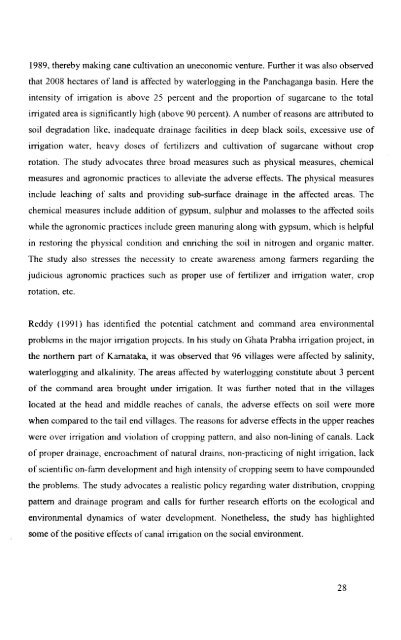Water Users Association and Irrigation Management - Institute for ...
Water Users Association and Irrigation Management - Institute for ...
Water Users Association and Irrigation Management - Institute for ...
Create successful ePaper yourself
Turn your PDF publications into a flip-book with our unique Google optimized e-Paper software.
1989, thereby making cane cultivation an uneconomic venture. Further it was also observed<br />
that 2008 hectares of l<strong>and</strong> is affected by waterlogging in the Panchaganga basin. Here the<br />
intensity of irrigation is above 25 percent <strong>and</strong> the proportion of sugarcane to the total<br />
irrigated area is significantly high (above 90 percent). A number of reasons are attributed to<br />
soil degradation like, inadequate drainage facilities in deep black soils, excessive use of<br />
irrigation water, heavy doses of fertilizers <strong>and</strong> cultivation of sugarcane without crop<br />
rotation. The study advocates three broad measures such as physical measures, chemical<br />
measures <strong>and</strong> agronomic practices to alleviate the adverse effects. The physical measures<br />
include leaching of salts <strong>and</strong> providing sub-surface drainage in the affected areas. The<br />
chemical measures include addition of gypsum, sulphur <strong>and</strong> molasses to the affected soils<br />
while the agronomic practices include green manuring along with gypsum, which is helpful<br />
in restoring the physical condition <strong>and</strong> enriching the soil in nitrogen <strong>and</strong> organic matter.<br />
The study also stresses the necessity to create awareness among farmers regarding the<br />
judicious agronomic practices such as proper use of fertilizer <strong>and</strong> irrigation water, crop<br />
rotation, etc.<br />
Reddy (1991) has identified the potential catchment <strong>and</strong> comm<strong>and</strong> area environmental<br />
problems in the major irrigation projects. In his study on Ghata Prabha irrigation project, in<br />
the northern part of Karnataka, it was observed that 96 villages were affected by salinity,<br />
waterlogging <strong>and</strong> alkalinity. The areas affected by waterlogging constitute about 3 percent<br />
of the comm<strong>and</strong> area brought under irrigation. It was further noted that in the villages<br />
located at the head <strong>and</strong> middle reaches of canals, the adverse effects on soil were more<br />
when compared to the tail end villages. The reasons <strong>for</strong> adverse effects in the upper reaches<br />
were over irrigation <strong>and</strong> violation of cropping pattern, <strong>and</strong> also non-lining of canals. Lack<br />
of proper drainage, encroachment of natural drains. non-practicing of night irrigation, lack<br />
of scientific on-farm development <strong>and</strong> high intensity of cropping seem to have compounded<br />
the problems. The study advocates a realistic policy regarding water distribution, cropping<br />
pattern <strong>and</strong> drainage program <strong>and</strong> calls <strong>for</strong> further research ef<strong>for</strong>ts on the ecological <strong>and</strong><br />
environmental dynamics of water development. Nonetheless, the study has highlighted<br />
some of the positive effects of canal irrigation on the social environment.<br />
28
















